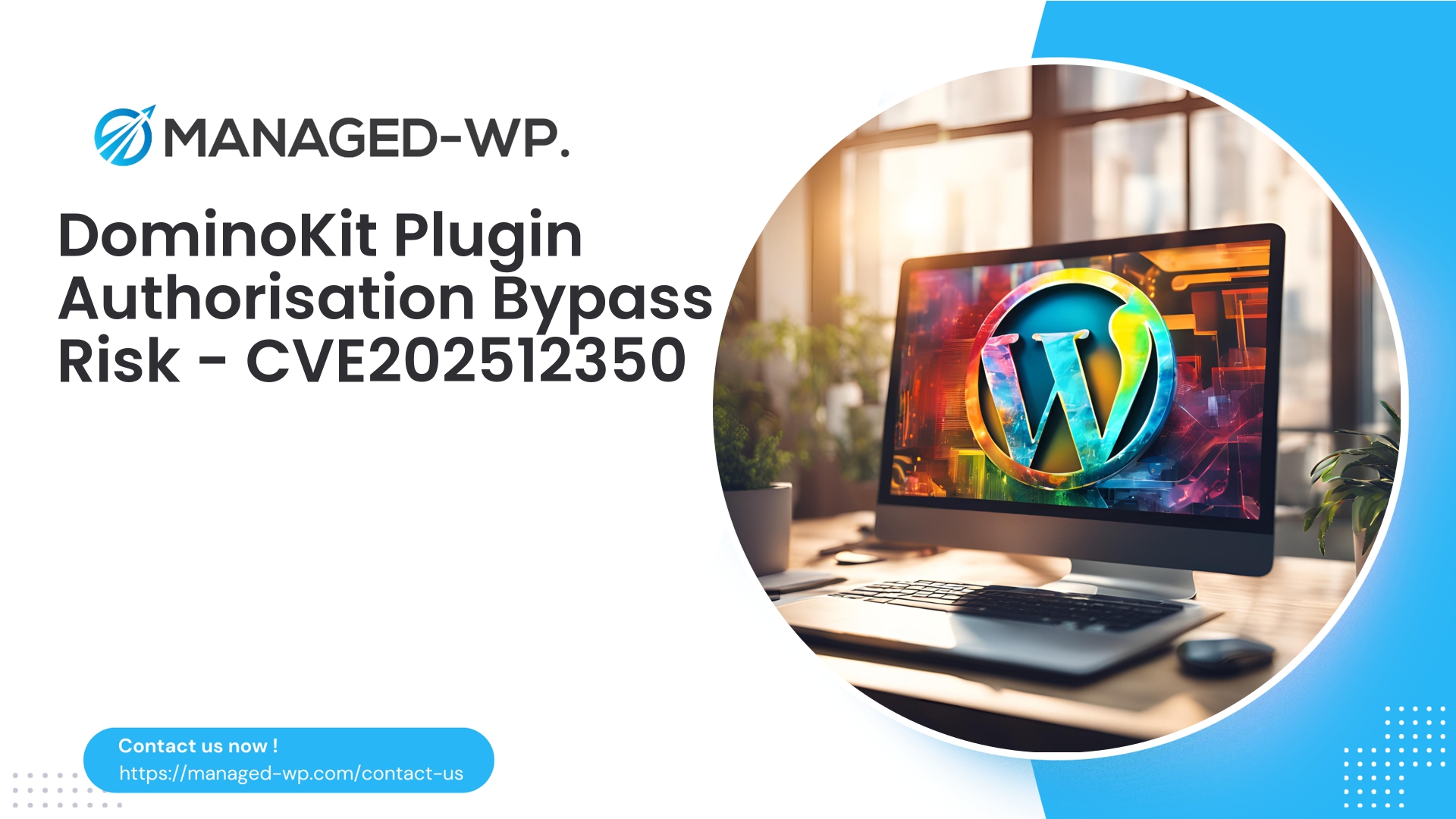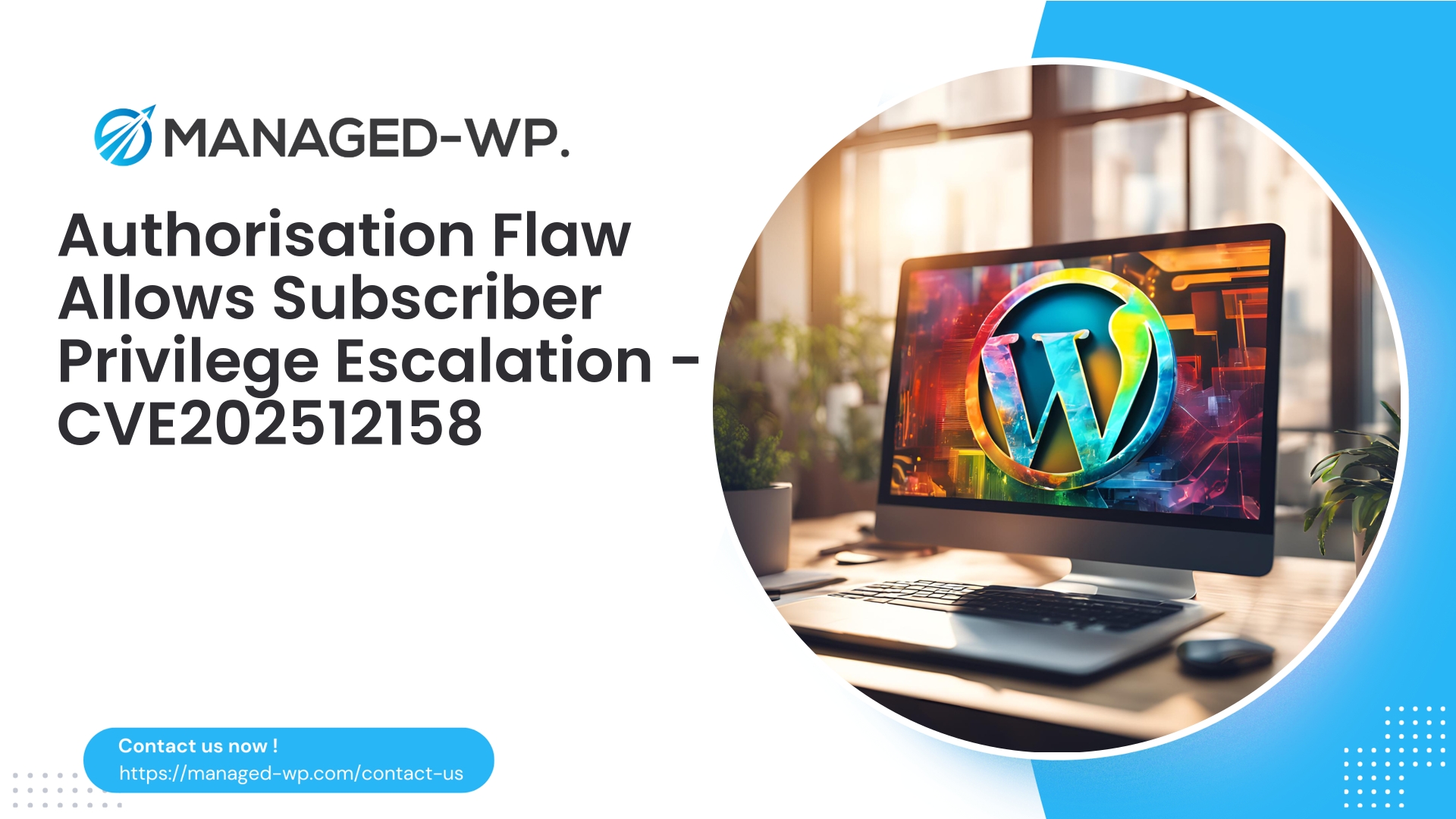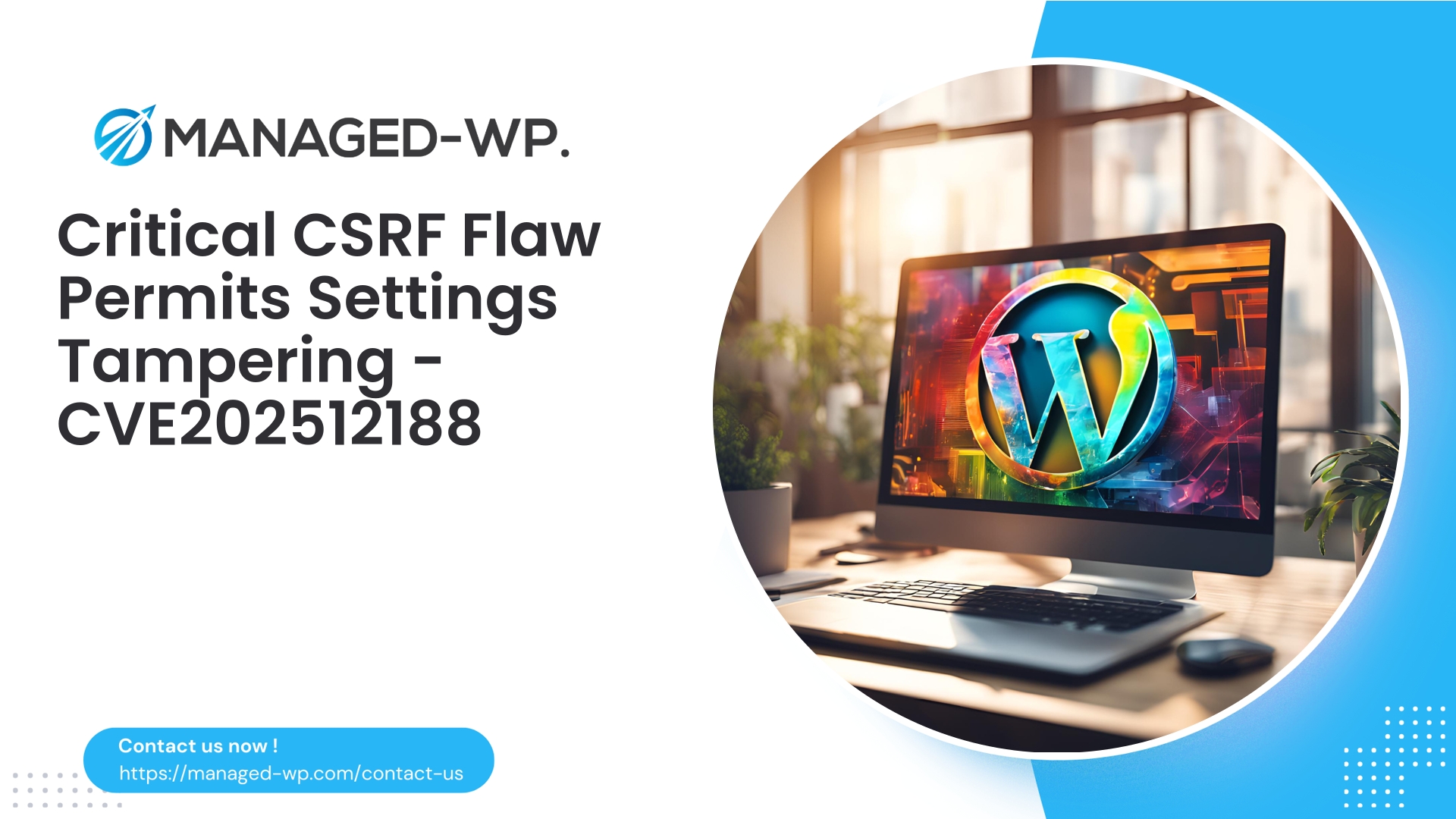| Plugin Name | DominoKit |
|---|---|
| Type of Vulnerability | Missing Authorization |
| CVE Number | CVE-2025-12350 |
| Urgency | Low |
| CVE Publish Date | 2025-11-04 |
| Source URL | CVE-2025-12350 |
DominoKit <= 1.1.0 — Missing Authorization Enables Unauthorized Settings Modification (CVE-2025-12350)
At Managed-WP, our US-based security experts provide a straightforward, actionable analysis of the DominoKit plugin vulnerability identified as CVE-2025-12350. This briefing is designed to empower WordPress site owners, administrators, and developers with essential information to assess risk, detect exposure, and apply practical mitigations. We cover the core vulnerability, attacker impact, detection methods, immediate mitigations, and developer best practices—plus how Managed-WP offers immediate protection where plugin patches are not yet available.
As hands-on professionals managing WordPress security daily, we avoid technical jargon, focusing instead on clear examples, configuration tips, and detection techniques that you can implement without delay.
Executive Summary
- Vulnerability: Broken access control / missing authorization in DominoKit plugin versions <= 1.1.0.
- Identifier: CVE-2025-12350.
- Impact: Unauthenticated attackers can invoke sensitive settings update functions in the plugin to change its configuration without any permission checks. This can lead to persistent site misconfiguration, phishing redirects, malicious script injection, or features that facilitate further exploitation.
- Severity: Medium/Low (CVSS 5.3). Although the direct technical impact varies based on plugin settings in use, the major concern is that no authentication is required for exploitation.
- Official Fix: None available at the time of writing. Immediate mitigation is necessary.
- Immediate Protective Options: Disable or remove the plugin, block vulnerable endpoints, implement WAF/virtual patch rules, restrict access with host-level controls, monitor logs, and follow developer patch guidance.
Understanding the Issue (Plain English)
The DominoKit plugin contains endpoints that update plugin settings without verifying the requester’s authorization. Typically, this happens when a plugin exposes handlers—via admin AJAX calls, REST API endpoints, or direct POST targets—that update options but either:
- Do not require a valid security nonce, or
- Fail to check user capabilities via
current_user_can(), or - Have REST routes without proper
permission_callbackprotection.
With these checks missing or faulty, anyone—including unauthenticated visitors—can call these endpoints and modify sensitive plugin settings.
Why this matters: Plugin settings often govern critical site behaviors such as redirect URLs, JavaScript injections, content alterations, third-party integrations, or file operations. Attackers exploiting this vulnerability can deface websites, launch phishing campaigns, establish persistent cross-site scripting (XSS), create backdoors, or enable attack chains that lead to privilege escalation or data theft.
Who Should Be Concerned
- Website owners running DominoKit plugin versions <= 1.1.0.
- Managed WordPress service providers hosting sites with DominoKit installed.
- Developers maintaining themes or custom plugins relying on DominoKit configuration.
- Security teams monitoring unauthorized POST requests to sensitive plugin endpoints.
If you use DominoKit and can’t update immediately (due to the lack of an official patch), consider this vulnerability urgent, as it is exploitable remotely without credentials.
Technical Breakdown: What Goes Wrong
The vulnerable process involves:
- Accepting a POST or REST API request to update plugin options.
- Reading the incoming parameters and updating options in the database (via
update_option(),update_site_option(), etc.). - Omitting validations such as nonce verification (
check_admin_referer(),check_ajax_referer()) or capability checks (current_user_can('manage_options')). - REST endpoints lack a
permission_callbackto verify authentication and authorization.
Common vulnerable patterns include:
- Admin AJAX actions without nonce or capability checks.
- REST routes with missing or permissive
permission_callbackfunctions. - Publicly accessible standalone plugin PHP files that update options without safeguards.
Result: Attackers can remotely trigger update_option() calls and change site configuration.
Potential Abuse Scenarios
An attacker could leverage this to:
- Redirect visitors to malicious or phishing websites.
- Inject unauthorized JavaScript snippets for cross-site scripting or data theft.
- Enable debug mode or unsafe file upload features to facilitate persistent compromise.
- Add tracking or analytics controlled by the attacker to steal visitor data.
- Modify content templates to serve malicious payloads like phishing or cryptomining scripts.
- Alter webhook or API key configurations to exfiltrate data or receive commands.
Combined, these actions could facilitate complex attack campaigns with no need for credentials, making automated attacks trivial.
Detection: How to Check if Your Site is Vulnerable
- Verify plugin version on your WordPress Dashboard under Plugins; if DominoKit version is <= 1.1.0, assume the plugin is vulnerable.
- Examine your site logs for suspicious POST or PUT requests such as:
- POSTs to
/wp-admin/admin-ajax.phpwith action parameters related to DominoKit (e.g. containing “domino”, “dominokit”, or plugin-specific actions). - POST requests directly targeting plugin PHP files within
/wp-content/plugins/dominokit/from external IP addresses. - REST API POST/PATCH calls to DominoKit-related WP-json routes.
- POSTs to
- Look for sudden or recent changes to DominoKit options in the database:
- Run:
SELECT option_name, option_value FROM wp_options WHERE option_name LIKE '%dominokit%'; - Compare recent backups or site snapshots to identify unauthorized changes.
- Run:
- Audit server error and access logs for coincidences with suspicious traffic spikes or configuration changes.
- Check file modification timestamps if you maintain backups or snapshots, looking for unauthorized plugin file changes.
Keep in mind that the absence of clear indicators does not guarantee safety, as attackers can probe silently.
Immediate Mitigations to Implement
Until an official patch is issued, apply one or more of the following controls:
- Deactivate or Remove DominoKit
- Deactivating the plugin is the most direct way to eliminate risk.
- If the plugin is essential, proceed with other mitigations below.
- Deploy Managed Firewall or Virtual Patch Rules
- Configure rules that block unauthenticated POST requests targeting DominoKit endpoints like admin-ajax actions or REST routes.
- Managed-WP offers virtual patches to block these exploits instantly for customers.
- Restrict Access via Web Server Rules
- Apache example (.htaccess) to block POST to plugin files:
<IfModule mod_rewrite.c> RewriteEngine On RewriteCond %{REQUEST_METHOD} POST RewriteCond %{REQUEST_URI} ^/wp-content/plugins/dominokit/ [NC] RewriteRule ^ - [F,L] </IfModule> - Nginx example to deny POST requests:
location ~* ^/wp-content/plugins/dominokit/ { if ($request_method = POST) { return 403; } } - These rules may disrupt legitimate plugin functionality, so test on staging environments first.
- Apache example (.htaccess) to block POST to plugin files:
- Block or Validate Specific Ajax/REST Actions
- If you know the plugin action parameters (e.g.,
action=dominokit_save), deny unauthenticated requests using WAF or server rules. - Apache example to block specific admin-ajax POSTs:
<If "%{REQUEST_METHOD} == 'POST' && %{REQUEST_URI} =~ m#/wp-admin/admin-ajax.php# && %{QUERY_STRING} =~ /action=dominokit_save/"> Require all denied </If>Adjust syntax per your server configuration.
- If you know the plugin action parameters (e.g.,
- Limit REST Route Exposure
- Block unauthenticated access to REST endpoints related to DominoKit until patched (e.g.,
/wp-json/domino*/). - Optionally apply allowlists for tokens or trusted IPs.
- Block unauthenticated access to REST endpoints related to DominoKit until patched (e.g.,
- Harden Administrative Access
- Restrict wp-admin access to known IPs where possible.
- Enforce strong passwords and enable multi-factor authentication to reduce lateral movement risks.
- Set Up Monitoring and Alerting
- Log and alert on unauthorized POST requests to plugin endpoints.
- Watch for unexpected option changes and suspicious file system activity.
- Maintain forensic evidence for incident response.
Conceptual WAF Rules
Consider rules that:
- Block unauthenticated POST requests to URIs containing
/wp-content/plugins/dominokit/without a WordPress logged-in cookie. - Block admin-ajax.php POST requests with known vulnerable action parameters.
- Block unauthenticated REST API calls to DominoKit namespaces.
Managed-WP customers receive custom-tuned virtual patches that minimize false positives and prevent exploit attempts.
Developer Guidance: Proper Fix Implementation
If you maintain DominoKit’s code, apply the following best practices to secure your plugin:
- For admin-ajax handlers:
- Verify nonces with
check_ajax_referer(). - Check user capabilities with
current_user_can('manage_options'). - Example handler:
add_action('wp_ajax_domino_save_settings', 'domino_save_settings_handler'); function domino_save_settings_handler() { // Verify the nonce sent by the admin UI check_ajax_referer('domino_settings_nonce', 'security'); // Verify the user capability if ( ! current_user_can( 'manage_options' ) ) { wp_send_json_error( 'Unauthorized', 403 ); } // Sanitize input and update options $val = isset( $_POST['some_setting'] ) ? sanitize_text_field( wp_unslash( $_POST['some_setting'] ) ) : ''; update_option( 'domino_some_setting', $val ); wp_send_json_success( 'Settings updated' ); }
- Verify nonces with
- For REST API endpoints:
- Use
permission_callbackfor authorization checks. - Example registration:
register_rest_route( 'domino/v1', '/settings', array( 'methods' => 'POST', 'callback' => 'domino_rest_update_settings', 'permission_callback' => function() { return current_user_can( 'manage_options' ); } ) );
- Use
- For direct POST handlers (non REST/AJAX):
- Use
check_admin_referer()for admin form submissions and always verifycurrent_user_can(). - Do not rely solely on
is_admin()for security.
- Use
- Sanitize and validate all inputs before database writes; escape outputs when rendering.
- Store sensitive HTML in a sanitized way to prevent injection.
- Log administrative changes for audit trails.
Following these corrections will ensure long-term security and compliance with WordPress best practices.
Verifying the Fix
- Test endpoints with unauthenticated POST requests; these should be denied with 403 or equivalent errors.
- Confirm administrative interfaces remain functional for authorized users.
- Check logs for blocked unauthorized attempts.
- Implement unit or integration tests verifying nonce and capability checks to prevent regressions.
Detection, Logging, and Forensics Recommendations
- Enable
WP_DEBUG_LOGon staging; use centralized logging solutions on production. - Log details for suspicious requests including timestamp, IP, HTTP method, URI, headers, user agent, and summarized request body (exclude sensitive data).
- Periodically snapshot
wp_optionsand relevant plugin tables to identify configuration drift. - If exploitation is suspected, preserve all logs and backups; consider taking the site offline and engaging incident response professionals.
Risk Evaluation — Why CVSS 5.3 Yet Still Critical
The CVSS score of 5.3 indicates moderate impact because:
- The vulnerability is remotely exploitable without credentials.
- The exploit involves updating settings rather than immediate code execution, database compromise, or data leakage.
- However, altered settings can lead to subsequent attacks such as redirects, script injection, or persistent access.
Given the potential for chained attacks and the lack of any authentication barrier, this vulnerability warrants urgent attention proportional to the plugin’s impact on your site.
Example Detection Queries
- Search web server logs for suspicious POSTs:
grep "admin-ajax.php" access.log | grep -i "POST" | grep -i "dominokit"grep "/wp-content/plugins/dominokit" access.log | grep "POST"
- Check recent option changes in database:
SELECT option_name, option_value, option_id FROM wp_options WHERE option_name LIKE '%domino%' ORDER BY option_id DESC LIMIT 50;
- Check plugin version via WP-CLI:
wp plugin get dominokit --field=version
Coordinated Response & Responsible Disclosure
In case of suspected exploitation:
- Preserve logs and backups without delay.
- Isolate the compromised site if there is evidence of malicious activity or unauthorized admin accounts.
- Consider restoring from a known good backup.
- If managing multiple sites with DominoKit, escalate attention and communicate risk promptly to all stakeholders.
How Managed-WP Provides Practical Protection
Managed-WP’s managed WordPress security service offers:
- Rapid virtual patching: deployment of WAF signatures instantly blocking unauthenticated exploit attempts on vulnerable plugin endpoints.
- Fine-tuned security rules minimizing false positives while blocking real threats.
- Real-time monitoring and alerting to notify you of exploitation attempts.
- Concierge-level remediation guidance to help secure your site effectively.
Choose proactive managed security to dramatically shorten your exposure window ahead of official patches.
Start Protecting Now With Managed-WP Free Plan
Essential WordPress Security At Zero Cost
You don’t have to wait to improve your security posture. Managed-WP’s Free Plan includes:
- Managed firewall with WordPress-specific prebuilt rules.
- Unlimited bandwidth and full Web Application Firewall (WAF) protection.
- Malware scanning for known threats.
- Virtual mitigations for OWASP Top 10 vulnerabilities.
Upgrade options add automated malware remediation, IP allow/deny controls, monthly reports, and virtual patching for new vulnerabilities. Sign up now at:
https://managed-wp.com/free-plan
Immediate Action Checklist
- Verify your DominoKit plugin version; if <= 1.1.0, treat as vulnerable.
- If possible, deactivate and remove DominoKit until a patched version is released.
- If removal is not viable:
- Apply webserver rules blocking unauthenticated POSTs to the plugin’s files.
- Deploy WAF rules or enable Managed-WP virtual patch signatures to prevent exploitation.
- Restrict administrative access and REST APIs to trusted IPs where feasible.
- Audit logs and option values for suspicious activity and retain evidence for investigation.
- Monitor official DominoKit vendor channels for updates; apply patches immediately once available.
- Consider signing up for Managed-WP security services to gain immediate managed protection.
Final Recommendations from Managed-WP
Unauthenticated configuration modification vulnerabilities are particularly dangerous since they bypass authentication altogether. Our advice: reduce attack surface quickly through containment (plugin removal or blocking endpoints), then implement prevention and monitoring using firewalls and logs. Finally, fix the issue at its source by enforcing proper authorization checks and security best practices.
If you require help with server rule implementation, targeted WAF signature creation, or forensic analysis, Managed-WP’s expert team is available to assist in securing your WordPress environment swiftly.
Protect your business and reputation by addressing this risk without delay.
Regards,
The Managed-WP Security Team
Resources & Reference Documentation
- CVE Identifier: CVE-2025-12350
- WordPress Security Resources:
- Best practices for secure AJAX and REST API development, including
current_user_can(),check_ajax_referer(),check_admin_referer(), and RESTpermission_callbackusage.
- Best practices for secure AJAX and REST API development, including
- Verification and Database Queries: Use WP-CLI and MySQL queries provided above for fast vulnerability checks.
Take Proactive Action — Secure Your Site with Managed-WP
Don’t risk your business or reputation due to overlooked plugin flaws or weak permissions. Managed-WP provides robust Web Application Firewall (WAF) protection, tailored vulnerability response, and hands-on remediation for WordPress security that goes far beyond standard hosting services.
Exclusive Offer for Blog Readers: Access our MWPv1r1 protection plan—industry-grade security starting from just USD20/month.
- Automated virtual patching and advanced role-based traffic filtering
- Personalized onboarding and step-by-step site security checklist
- Real-time monitoring, incident alerts, and priority remediation support
- Actionable best-practice guides for secrets management and role hardening
Get Started Easily — Secure Your Site for USD20/month:
Protect My Site with Managed-WP MWPv1r1 Plan
Why trust Managed-WP?
- Immediate coverage against newly discovered plugin and theme vulnerabilities
- Custom WAF rules and instant virtual patching for high-risk scenarios
- Concierge onboarding, expert remediation, and best-practice advice whenever you need it
Don’t wait for the next security breach. Safeguard your WordPress site and reputation with Managed-WP—the choice for businesses serious about security.
Click above to start your protection today (MWPv1r1 plan, USD20/month).



















